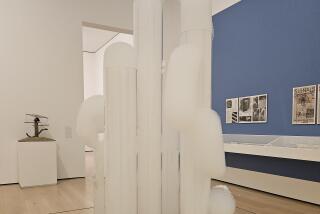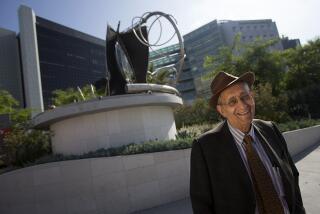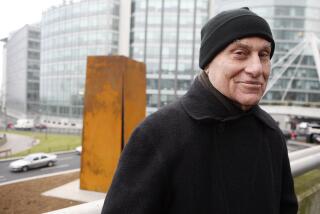Italo Scanga; Made Art by Recycling Found Objects
Italo Scanga, an innovative neo-Dadaist, neo-Expressionist and neo-Cubist multimedia artist who made sculptures of ordinary objects and created prints, glass and ceramic works, has died. He was 69.
Scanga, whose works were exhibited at the Los Angeles County Museum of Art, New Yorkâs Whitney and Museum of Modern Art, and galleries up and down the West Coast, died Friday of a heart attack at his studio home in La Jolla. Born in Lago, Italy, Scanga attributed his penchant for recycling things to the poverty of his childhood.
His sculptures included wooden animals, papier-mache vegetables, vases of cut flowers, rope, antique irons, shoes, shovels and musical instruments. He often scoured swap meets and thrift shops to collect items he could glue into his collage sculptures.
âHe was an alchemist when it came to transforming found objects into art,â said Hugh Davies, director of the San Diego Museum of Contemporary Art. âHe was a collagist equally at home sculpting or painting, and frequently combined both.â
Scanga discussed his work with The Times in 1985, explaining: âIâm using a real guitar. Now Picasso, in his Cubist paintings, will paint the guitar because itâs a symbol--of freedom, individual expression, whatever--whereas I just put a real guitar in the work and paint on it. . . . I go back to Cubism without hiding it. . . . People say you gotta hide the sources. I donât hide anything.â
Scanga, who said his family discouraged his interest in art and hoped he would sell groceries, came to the United States in 1947 when he was 15. He earned bachelorâs and masterâs degrees from Michigan State University after serving in the U.S. Army.
Although he created steadily, Scanga did not become a commercially successful artist until he was nearly 50. He supported his work by teaching--at the University of Wisconsin, the Rhode Island School of Design, Pennsylvania State University and the Tyler School of Art.
In 1976, UC San Diego lured him to California as a visiting professor and, by promising him a studio, hired him for its faculty permanently in 1978. The self-described gypsy teacher and artist had found a home.
Settling in California, he told The Times in 1988, changed his work, making it âvery colorful, very joyous, happy work. It was about the good things in life, not about the horrible things. It wasnât always tragic, like my earlier work.â
Successful with his art and his teaching, Scanga struggled with what he called the schizophrenia of pursuing both. âGreat, great, great artists,â he insisted, âwere never teachers.â
The artistâs amazing range--he even decorated handkerchiefs--confounded fans and critics alike. He could, one wrote, âpaint ceramic plates in a light, buoyant style, full of charm and color . . . assemble sculptures out of leather belts, metal machinery fragments and scavenged wood . . . paint and make prints . . . and illustrate poems on sheets of old liturgical music.â
Another wrote: âScanga tends to roam at will around the art history map, endearingly oblivious to boundary or rule. His work might be figurative one moment, only to wander off into abstraction in the next passage.â
Scangaâs painted ceramic plates, in particular, often incorporated the names and imagery of some of his favorite artists and composers--Picasso, Mozart and Copland--becoming in effect public fan letters.
The artist staged about 80 one-man shows and contributed pieces to more than 225 group exhibitions across the United States and in Europe. Examples of his work were published in the Arts Yearbook of Contemporary Sculpture, Glass Art Mag, Art in America and other publications.
Scanga received several grants, including one from the National Endowment for the Arts.
For the last several years, Scanga lived in La Jolla with Thailand-born chef and cookbook author Su-Mei Yu. He is survived by her, five children from a previous marriage and four grandchildren.
More to Read
The biggest entertainment stories
Get our big stories about Hollywood, film, television, music, arts, culture and more right in your inbox as soon as they publish.
You may occasionally receive promotional content from the Los Angeles Times.










